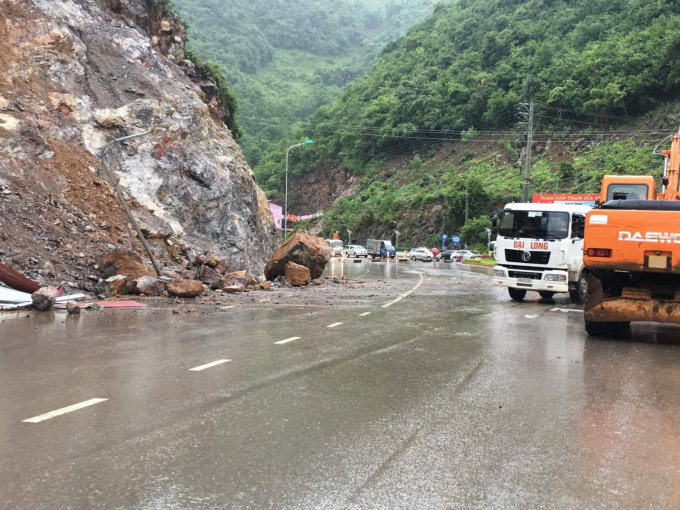Prevention of natural disasters for roadworks already opened to traffic and use in Vietnam from January 01, 2025
Below are the regulations on disaster prevention for road infrastructure that has been put into operation and use in Vietnam from January 1, 2025.

Prevention of natural disasters for roadworks already opened to traffic and use in Vietnam from January 01, 2025 (Image from the internet)
On November 15, 2024, the Minister of Transport of Vietnam issued Circular 40/2024/TT-BGTVT, stipulating the work of prevention, control, and mitigation of natural disaster consequences in the road traffic.
Prevention of natural disasters for roadworks already opened to traffic and use in Vietnam from January 01, 2025
Disaster prevention for road works in operation is regulated in Article 8 of Circular 40/2024/TT-BGTVT as follows:
The Road Management Unit, road managers, users, road works maintenance contractors, and companies investing in the construction and management of road work operations within their management scope, are responsible for implementing the following disaster prevention measures:
(1) For small bridges and culverts:
- For small bridges: ensure the flow is clear, including upstream and downstream, to ensure proper drainage. Parts prone to erosion, such as abutment slopes, bridge head roads, footings, and energy dissipation structures should be repaired and reinforced before the rainy and stormy seasons.
- For culverts: clear sediment buildup in chambers, clean culvert interiors, both before and during the rainy and stormy seasons, and reinforce headwalls and energy dissipation structures. Culverts located in areas with stones and floating trees must have strengthening measures to prevent blockage.
(2) For medium and large bridges:
- Conduct regular, periodic inspections as required, and carry out annual repairs and reinforcements, especially for components vulnerable to rain and floods.
- For bridges in areas with stones and floating trees: regularly inspect and remove trees and debris to prevent accumulation on pillars and the underside of beams.
- For rivers and streams with altered flows: implement course correction measures and reinforce both banks and bridge abutments appropriately.
- For large bridges: consistently monitor wind speed on the bridge; if the wind speed exceeds the design limits, promptly close the bridge (halt traffic) and announce traffic detours to ensure safety for people and vehicles.
(3) For road embankment: embankment slopes, and shoulders should be cleared of grass and graded according to design slope specifications. Areas with unstable embankment geology should have retaining walls or slope reinforcements, and frequently flooded roadways should have reinforced shoulders and slopes using inundation-resistant road surface structures.
(4) For drainage ditches (including longitudinal, ridge, water step, and slope drains): clear foliage, dredge mud and stones to ensure proper drainage. Any damage affecting drainage capacity must be repaired before the rainy and flood seasons.
(5) For overflow roads and submerged sections: repair surfaces, embankments, upstream and downstream energy dissipation areas, and repaint signaling systems, poles, and water level markers. After water recedes, inspect the state of overflow roads and submerged sections, and allow passage only when safety is assured.
(6) For floating systems, pontoon bridges, ferries, and canoes:
- Securely fix any equipment on the vehicle to prevent damage or displacement during operation.
- Ensure watertightness of all deck hatches, and ensure there are no holes or leaks in the hull, bottom of the pontoon, or ferry.
- Maintain good operating condition for the vehicles, ensuring the pumping system can effectively dewater hulls and vessels, and that open decks have adequate drainage holes for effective water evacuation.
- Adequate storage and anchorage systems must be in place to secure ferries and pontoons during emergencies.
- Equip sufficient life-saving and fire-fighting equipment.
(7) For road tunnels and underpasses:
- Implement suitable disaster prevention measures matching the scale of the project; forecast potential scenarios (power outages, unforeseen excessive rainfall causing tunnel flooding).
- Regular inspections should be conducted to promptly repair and reinforce components vulnerable to natural disasters such as electrical systems, pumping systems, drainage, erosion control, and debris and tree abrasions at both tunnel entrances.
Principles of disaster prevention, control, mitigation, and rescue in road traffic in Vietnam
Activities related to disaster prevention, control, mitigation, and rescue in road traffic in Vietnam must adhere to the following principles:
- Compliance with basic principles of disaster prevention and rescue operations as stipulated in Article 4 of the Law on Disaster Prevention and Control 2013.
- When a disaster weakens or after weather conditions return to normal, organizations and individuals should implement designated measures to respond to and repair road work damages to restore traffic operations, ensuring safe and uninterrupted transportation.
- The proposed disaster prevention, control, and mitigation measures in the plan must be supported with adequate human and material resources according to the four on-the-spot motto “local command; local forces; local means and materials; local logistics” to minimize disaster consequences and ensure the shortest possible response and recovery time.
- Ensure safety for individuals and vehicles involved in disaster prevention, control, and mitigation activities, as well as for transport infrastructure and modes operating on the roads; minimize incidents and accidents resulting from the very activities of prevention and mitigation of disaster consequences.
- Key word:
- natural disaster
- roadwork
- Vietnam
- Number of deputy directors of departments in Vietnam in accordance with Decree 45/2025/ND-CP
- Cases ineligible for pardon in Vietnam in 2025
- Decree 50/2025 amending Decree 151/2017 on the management of public assets in Vietnam
- Circular 07/2025 amending Circular 02/2022 on the Law on Environmental Protection in Vietnam
- Adjustment to the organizational structure of the Ministry of Health of Vietnam: Certain agencies are no longer listed in the organizational structure
- Vietnam aims to welcome 22-23 million international tourists in Vietnam in 2025
-

- Number of deputy directors of departments in Vietnam ...
- 15:04, 05/03/2025
-

- Cases ineligible for pardon in Vietnam in 2025
- 14:43, 05/03/2025
-

- Decree 50/2025 amending Decree 151/2017 on the ...
- 12:00, 05/03/2025
-

- Circular 07/2025 amending Circular 02/2022 on ...
- 11:30, 05/03/2025
-

- Adjustment to the organizational structure of ...
- 10:34, 05/03/2025
-

- Notable new policies of Vietnam effective as of ...
- 16:26, 11/04/2025
-
.Medium.png)
- Notable documents of Vietnam in the previous week ...
- 16:21, 11/04/2025
-
.Medium.png)
- Notable documents of Vietnam in the previous week ...
- 16:11, 02/04/2025
-
.Medium.png)
- Notable new policies of Vietnam to be effective ...
- 16:04, 02/04/2025
-
.Medium.png)
- Notable new policies of Vietnam effective from ...
- 14:51, 21/03/2025

 Article table of contents
Article table of contents
